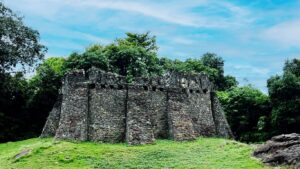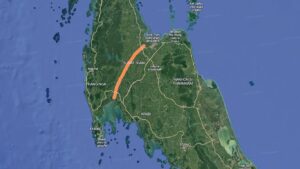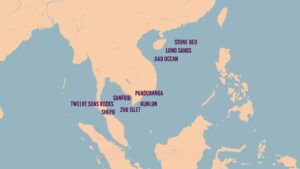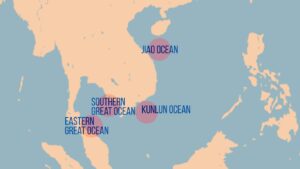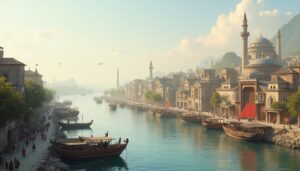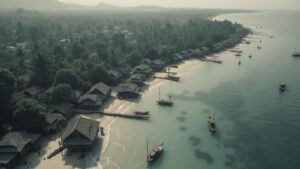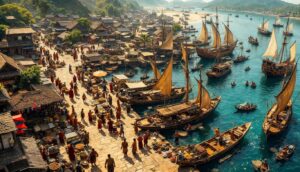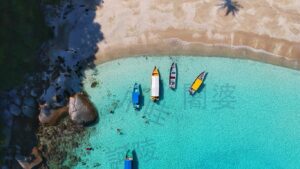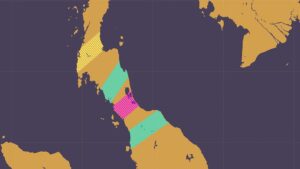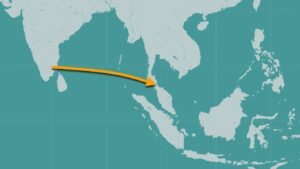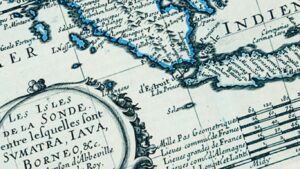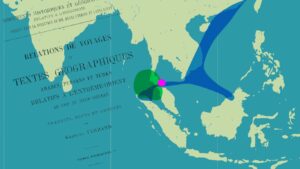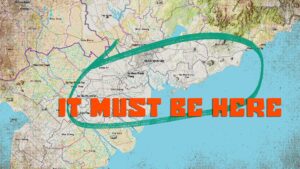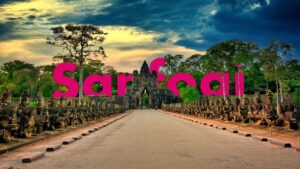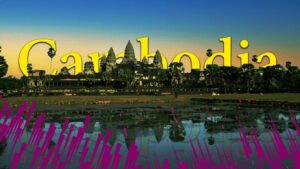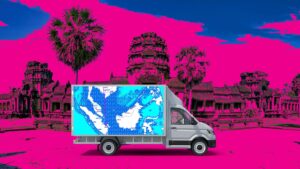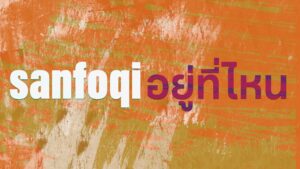One of the first papers I ever published was called “Thoughts on a Chinese Diaspora: The Case of the Mạcs of Hà Tien” (2000). I wrote it as a final paper in a graduate seminar on diasporas in world history. The paper was about a group of Chinese refugees, under...
Read MoreSanfoqi & Srivijaya
I have written a lot about “Sanfoqi & Srivijaya” over the past few years. This post has links to my published writings on this topic.
There are details or ideas in some of the blog posts that I have written that I no longer believe. In some instances, I have left notes in blog posts to indicate that, but at other times, I have not noted anything.
To get the clearest idea of what I think/argue, please read my published writings. That said, there is a lot that I have written about in blog posts that relates to this topic that has not yet made its way into print, so I still think some of those posts are valuable, particularly the ones in the “Sanfoqi 3.0” series.
That said, there is information in earlier posts that is still useful too. Enjoy!!!
Locating Foluo’an 佛羅安
Over the past several years, I have been going through the Chinese sources for Southeast Asian history and reinterpreting them. One big issue that I have found is that people have wrongly identified certain place names, and that has created a lot of confusion in the scholarship that bases itself...
Read MoreThe History of Cambodia You Never Knew About
As I have been writing for years now, there is a place name in Chinese sources, Sanfoqi 三佛齊, which, for the past 100+ years, scholars have thought indicated a place on the southern end of the island of Sumatra which they think was the capital of a polity called “Srivijaya.”...
Read MoreThe Lost Water Route between Songkhla and Nakhon Si Thammarat
Five years ago, I listened to a colleague at Universiti Brunei Darussalam, Johannes Kurz, give a presentation on how problematic the scholarship on “Srivijaya” is, and in particular, how problematic the use of Chinese sources has been in that body of scholarship. That all made sense to me, because although...
Read MoreDid Funan Have a Cham King?
I have recently been examining a fourth-century text Daoist text, the Grand Clarity Scripture of Divine Elixir Made from Liquid Gold (Taiqing jinye shendan jing 太清金液神丹經) attributed to Ge Hong 葛洪 (283–343 CE), that has information about some parts of Southeast Asia. I have translated those parts here. I have...
Read MoreThe Surat Thani – Phang Nga Crossing in the Third-Fourth Centuries
In the third century, there were a couple of envoys who traveled to Funan and wrote accounts of the area. Namely, the following: Kang Tai 康泰, Account of Foreign Kingdoms in the Wu Period (Wushi waiguo zhuan 吳時外國傳). This work was also known as the Account of Funan (Funan zhuan...
Read MoreOn NOT Crossing the Sea from Côn Đảo to Singapore
If you read the extent scholarship on Southeast Asia in the first millennium AD, you will find scholars repeatedly indicating that ships sailed across the seas between the area of what is now Côn Đảo, at the southeastern tip of the Indochinese Peninsula, and Singapore. The image above contains two...
Read MoreThe Chicken Tongue Aromatic (shejixiang) was NOT Cloves
There is an aromatic that is mentioned in early Chinese sources called the “chicken tongue aromatic” (jishexiang 雞舌香). From what I can tell, everyone who has mentioned it thinks it is a reference to cloves. It’s clear to me, however, that it is not. One place where it is mentioned...
Read MoreGe Hong’s Five Kingdoms
In the previous post, I translated information about Southeast Asia in an early fourth-century text entitled Grand Clarity Scripture of Divine Elixir Made from Liquid Gold (Taiqing jinye shendan jing 太清金液神丹經) that is attributed to the Daoist, Ge Hong 葛洪(283–343 CE). Ge Hong has a long introduction to the section...
Read MoreThird-Fourth Century Maritime Southeast Asia in a Daoist Text
I recently came to realize that there is geographic information about third-fourth century maritime Southeast Asia in a Daoist text, the Grand Clarity Scripture of Divine Elixir Made from Liquid Gold (Taiqing jinye shendan jing 太清金液神丹經). This text is attributed to Ge Hong 葛洪(283–343 CE), also known as “The Master...
Read MoreI FINALLY Figured Out Yijing!!
If you don’t know what this title means, then you can read these blog posts to find out more: “Yijing did NOT Visit Jambi/Srivijaya” “I Found “Malayu / Malaya / Malāyur!!!” The gist is that there is a Tang dynasty monk, Yijing, who traveled to India and back in the...
Read MoreThere is no Pulau Aur in Song Dynasty Era Sources
A few days ago, I posted a translation of information about maritime Southeast Asia in Zhou Qufei’s 周去非 1178 work, Lingwai daida 嶺外代答 [Representative Responses about the Region Beyond the Passes]. In that work, Zhou Qufei describes the route from to China from Sanfoqi, a place that I argue was...
Read MoreGeographic Space in the Lingwai Daida
I have just shared a translation that ChatGPT and I made of the sections in Zhou Qufei’s twelfth-century Lingwai daida that relate to maritime Southeast Asia. I would like to now start discussing the information in that text. I’ll begin by talking in general terms about the conceptions of space...
Read More12th-Century Maritime Southeast Asia in the Lingwai Daida
Zhou Qufei’s 周去非 1178 work, Lingwai daida 嶺外代答 [Representative Responses about the Region Beyond the Passes], is a very important Chinese source for information about maritime Southeast Asia at that time. For some reason, this work has never been translated. However, it should have been, and it should have been...
Read MoreCham Pu Muslims
In previous posts I have been challenging a long-held belief that a “surname” that appears in Chinese sources, “Pu,” indicates the Arab name, “Abu” or the Javanese-Malay title, “mpu/empu.” In this post, I would like to go a bit deeper by looking at a specific Cham clan that lived in...
Read MoreMore Evidence for the Cham Pu/Po in Chinese Historical Sources
In a recent blog post, I talked about how in Song dynasty era sources, there is a “surname” that appears in numerous Chinese records about tribute missions coming from Southeast Asia — “Pu” 蒲 – that scholars have argued indicates the Arabic name “Abu” or certain Southeast Asian terms. Among...
Read MoreMore Evidence of Two “Javas”
I have made the argument that there was a trans-peninsular empire/polity in the area of Songkhla – Kedah that foreigners referred to by the name “Java/Jaba,” and that it was only in the thirteenth century that foreign traders recorded information about island Java, at which point, there were “two Javas”...
Read MoreMore Evidence for the Trans-Peninsular Crossing at Kedah – Songkhla
In the previous post, I mentioned that there was a tribute mission from the Chola Kingdom in 1015 that was led by a certain Suolisanwen (娑里三文) with a deputy envoy Pu Shu 蒲恕 (or Pu Jiaxin 蒲加心), and I argued that the “Pu” here is the Cham honorific, pu/po. This...
Read MoreWhen the Cham Ruled the Seas
In Song dynasty era sources, there is a “surname” that appears in numerous records about tribute missions coming from Southeast Asia (and beyond), and that is “Pu” 蒲. This character appears in the names of envoys from various places. Over a century ago, there were scholars who proposed that this...
Read MoreThe Angkorian Independence from Java “Myth”
Several years ago, when I first started researching about “Srivijaya” and quickly realized that a place name in Chinese sources (Sanfoqi) that scholars thought indicated that supposed polity on Sumatra was actually a reference to “Kambuja,” I consulted an excellent 2011 dissertation from Berkeley by Ian Nathanial Lowman entitled “The...
Read MoreThe Myth of Jambi as a Capital of “Srivijaya”
I was reading a book that was published in 2022 called The Oxford Handbook of Early Southeast Asia. It contains a chapter on “Srivijaya” by Pierre-Yves Manguin. In that chapter, there is a section on “The Troubled Eleventh Century and the Shift to Jambi” where Manguin writes that “In the...
Read MoreRescuing History from Srivijaya – Part 2
A couple of years ago, I published an article entitled “Rescuing History from Srivijaya: The Fall of Angkor in the Ming Shilu (Part 1).” A continuation of that article, “Rescuing History from Srivijaya: The Fall of Angkor in the Ming Shilu (Part 2),” has just been published, and at some...
Read MoreHere is an Example of the Problem with the Scholarship on “Srivijaya”
As I have said a million times by now, there is a place name in Chinese historical sources, Sanfoqi 三佛齊, that in the early twentieth century, French scholar George Cœdès claimed indicated a place called “Srivijaya,” a polity supposedly based at Palembang on the island of Sumatra. As I have...
Read MoreI FINALLY Found Sanfoqi!!
Off and on over the past few years, I have been researching about a place called “Sanfoqi” 三佛齊. This is a name that appears in Chinese sources from the tenth through the fourteenth centuries, and it was clearly a very important trading center in Southeast Asia. Since the early twentieth...
Read MoreA Working Paper on the Chinese Sources on Early Southeast Asia
I’ve recently published a working paper entitled “Revisiting the Chinese Sources on Early Southeast Asia.” I started looking at the Chinese sources for early Southeast Asian history a few years ago, and discovered a lot of problems with the ways that modern scholars have understood and written about those materials....
Read MoreThe Zhu Fan Zhi and the Complete Mess Scholars Have Made
The scholarship on early Southeast Asian history that relies on Chinese sources is a complete mess. From the very beginning, scholars got a lot of things wrong, and then they just kept going and kept producing ever more flawed scholarship. By this point, the extant scholarship is simply unusable. If...
Read MoreSeeing Trans-Peninsular Networks in Chinese Historical Sources (Part 1)
Chinese historical sources have long been used to try to gain an understanding of early Southeast Asian history. However, when scholars have made use of these sources, they have usually done so without talking about the context in which that information is placed in Chinese historical sources. In other words,...
Read MoreSrivijaya 3.0 (21): The Language of Jāba – I Can’t Figure It Out
I have recently been writing a lot about a place that I refer to as “Jāba,” a kingdom that I argue was based in the area of what is now Songkhla in southern Thailand and which from the fifth to fourteenth centuries was an important node in a trans-peninsular trade...
Read MoreSrivijaya 3.0 (20): “Jāba” in the Đại Việt sử ký toàn thư
By now I think that I have clearly established the fact that there was a kingdom located in the area of what is now Songkhla that was at the center of an important trans-peninsular trade network. I refer to this kingdom as “Jāba” (although it may have actually been called...
Read MoreSrivijaya 3.0 (19): A Vietnamese Encounter with “Cha Ba” in the Early 19th Century
In 1810, two Vietnamese officials presented to Emperor Gia Long a map of the routes to, and within parts of, Siam with an accompanying text based on information they had acquired the previous year while on a diplomatic mission. Known as the Collected Records of the Routes in the Kingdom...
Read MoreSrivijaya 3.0 (18): The Burma-Jāba Connection
In many recent posts, I have been writing about a place that I call “Jāba.” This was the center of a major trans-peninsular trade empire, and it was located around the area of what is now Songkhla in southern Thailand. This place is referred to in various historical sources by...
Read MoreSrivijaya 3.0 (17): The “Chola Invasion of Srivijaya”
In the eleventh century, a place in Southeast Asia called “Srivishaya” was attacked by a kingdom from southern India known as the Chola kingdom. We know about this from inscriptions in Sanskrit and Tamil that have been found in India. What we also know from these inscriptions is that prior...
Read MoreSrivijaya 3.0 (16): The “Thai” Origin of the Mongol Invasion of Java
In early 1292, Kublai Khan, the Mongol emperor of the Yuan Dynasty in China, gave orders to three of his officials to lead troops to attack the island of Java. Why did he do this? The History of the Yuan states that when these men met with the emperor before...
Read MoreSrivijaya 3.0 (15): Marco Polo Visited Thailand
Yes, you read that correctly. Marco Polo visited Thailand. Ok, I know that there was no place called “Thailand” in the late thirteenth century when Marco Polo traveled across Southeast Asia on his way back to Venice, however, he did pass through places that are now part of Thailand. This...
Read MoreSrivijaya 3.0 (14): I Found “Malayu / Malaya / Malāyur”!!!
Ok, I think I have finally found “Malayu”!!! The term, “Malayu,” and the related terms of Malaya and Malāyur appear in several historical sources before the 1400s, and they clearly refer to a place. Where was that place? In a previous post, where I debunked the idea that Tang Dynasty...
Read MoreSrivijaya 3.0 (13): The Description of Jāba/Zābaj in Arabic Texts
Having shared the translations of some of the information in Arabic texts about Southeast Asia in the last post, let’s take a look at what they have to say about the place called Jāba/Zābaj, which I argue was a trans-peninsular trading empire that was based at Songkhla in what is...
Read MoreSrivijaya 3.0 (11): Why There were Two “Javas” in the 1200s-1300s
As stated in the previous post, there were two “Javas” in the past in Southeast Asia. These two Javas are referred to in Arabic, Chinese and other sources variously as Java/Jaba/Zabag/Shepo and mul-Java/Zhuawa. Originally only one Java was mentioned in historical sources. Then in the 1200s and 1300s both of...
Read MoreSrivijaya 3.0 (10): The Two “Javas” in Southeast Asia
One issue that has confused historians for over a century is the fact that there is more than one place that was referred to as “Java” (or something close to that name) in the past in Southeast Asia. I think this can be seen the clearest in Chinese sources, but...
Read MoreSrivijaya 3.0 (09): Yijing did NOT Visit Jambi/Srivijaya
There was a Chinese Buddhist monk by the name of Yijing 義淨 (635–713) who traveled to India in the second half of the seventh century and stayed there for 11 years. Yijing left some records of his journey, and that information has served as “evidence” for the existence of a...
Read MoreSrivijaya 3.0 (08): The Real China-India Maritime Route During the Tang Period
The belief that there was historically a dynamic and important maritime kingdom on the island of Sumatra called “Srivijaya” has created an incalculable number of problems for scholarship on premodern Southeast Asian history. This is because, over the past century, scholar after scholar after scholar has interpreted historical sources with...
Read MoreSrivijaya 3.0 (07): Jaba/Songkhla in The Crystal Sands
A colleague and friend pointed out to me that I should look at information in a work known as The Crystal Sands: The Chronicles of Nagara Sri Dharrmaraja. This is a Thai-language text that was translated into English and published in 1975 by the late historian David K. Wyatt. Cornell...
Read MoreSrivijaya 3.0 (05): Ok, So There WAS a Srivijaya. . . But It’s Not What You Think. . .
A while ago I made a video where I said something like “no place called Srivijaya ever existed”. . . I kind of knew at the time that I might end up eating those words, but I like to be provocative, and I had a strong sense at that time...
Read MoreRescuing History from Srivijaya Paper (Part 1)
At long last, the first part of a 2-part article on “Srivijaya” has just been published. In this article, I argue that information in Chinese sources (about “Sanfoqi” 三佛齊) that has been used to construct the history of a supposed maritime polity in Southeast Asia called “Srivijaya” is actually about...
Read MoreSrivijaya 3.0 (04): Revisiting the Arabic Sources for Southeast Asian History
I have recently come up with a new picture of premodern Southeast Asian history by revisiting Chinese, Siamese, and Cambodian sources. In particular, I have come to conclude that there was never a place called “Srivijaya,” a kingdom that was supposedly “rediscovered” by George Cœdès in 1918. Instead, I am...
Read MoreSrivijaya 3.0 (03): Angkor as an International Entrepôt
As I stated in the previous post (The “One Country – One King” Problem in Premodern Southeast Asian History), when historians have looked at the records of tribute missions to China from Southeast Asian polities in the past, they have generally viewed those records as representing tribute missions from individual...
Read MoreSrivijaya 3.0 (02): The “One Country – One King” Problem in Premodern Southeast Asian History
There is a major problem that plagues the scholarship on premodern Southeast Asian history, and I call it the “one king – one country” problem. When European scholars during the colonial period first examined Southeast Asian history and tried to develop political chronologies for the various polities in the region,...
Read MoreSrivijaya 3.0 (01): Yet Another Series
I can see everything clearly now. It all falls into place. It all makes sense. . . Over the past couple of years, I have provided extensive evidence to overturn the idea that there was ever a maritime kingdom called “Srivijaya.” This supposed kingdom was “discovered” by French scholar George...
Read MoreHow is it Possible that the “Srivijaya Myth” Could Last So Long?
I am well aware that many people are going to respond with immediate disbelief to the idea of the article that I am about to publish that there was no “Srivijaya” and that the information in Chinese sources about “Sanfoqi” that was employed to produce a history for “Srivijaya” is...
Read MoreWhat Does “Post-Srivijaya” Southeast Asian History Look Like?
I have recently written a long 2-part article that demonstrates that there was never a kingdom called “Srivijaya.” The first part will be published in a few days. Much of the information that was used to create the history of that supposed kingdom came from Chinese sources, and I have...
Read MoreThere Was No Srivijaya. I Am 100 Billion % Sure of That.
[Update: As I’ve researched this further, I’ve changed my mind a little bit. I still am 1 billion % sure that the “Srivjaya” that has been talked about in academic writings – that is, a supposed maritime polity based at Palembang – did not exist. What I think the “Srivjjaya/Srivishaya”...
Read MoreTake a Look at These Images and Ask Yourself. . .
The Google Ngram Viewer shows how many times certain terms appear in digitized printed texts. The image below shows what we see when we input the terms “Srivijiya” and “Sri Vijaya” in the Google Ngram Viewer. The Google search engine can show us how many websites contain a term that...
Read MoreSrivijaya 2.0 (14): If Coedès was This Bad when it Came to Srivijaya. . .
George Cœdès (1886-1969) was a French scholar of the Southeast Asian past who published prolifically, and through his writings, has exerted an enormous influence on the writing of premodern Southeast Asian history. Those writings include extensive translations of Cambodian inscriptions and a survey of early Southeast Asian history that was...
Read MoreSrivijaya 2.0 (13): The Ryukyu Letter to Siam that Proves Sanfoqi = Kambuja
On 8 October 1431, the king of Chuzan 中山, one of the principalities that made up the Kingdom of Ryukyu on the island of Okinawa, sent a letter to the King of Siam. It was a very polite letter, as diplomatic letters tend to be. But the king of Chuzan...
Read MoreThe Female Deity Worshipped by the Kings of Angkor
Did you know that Angkorian kings used to regularly travel to the lower Mekong region to worship a female deity? No, you didn’t know that. I know you didn’t. But don’t feel bad about that. It’s not your fault! You’re still as smart as ever. It’s more like you’ve been...
Read MorePremodern Southeast Asian Imperialism, Decolonizing Historical Knowledge, and the Liberal Bias in Western Historical Scholarship
In researching about “Srivijaya” recently, I have been reading about Southeast Asian history in the fourteenth and fifteenth centuries and I’ve come to realize something that I had not thought of before: There was big-time imperialism taking place in Southeast Asia before the European white boys showed up and tried...
Read MoreSrivijaya 2.0 (12): The Lost Multinational History of the Saigon – Vũng Tàu Coast?
Over the past few months, I have been demonstrating that information in Chinese sources that has been used for the past century to write about the history of an imagined polity called “Srivijaya” is actually about Cambodia. In particular, there is information in Chinese sources about a place called “Sanfoqi”...
Read MoreDeconstructing Srivijaya is Easy!
How can it be possible to deconstruct/debunk 100 years of scholarship in a couple weeks/months? In 2021, it’s actually pretty easy, and this video explains why that is the case. For more, see the series of posts on “Srivijaya 2.0.” https://youtu.be/2ag2LCBbnXw
Read MoreSrivijaya 2.0 (11): The Okinawan Evidence for Sanfoqi = Angkor
In these posts I have been demonstrating that a Chinese name (Sanfoqi) that scholars think refers to a kingdom on the island of Sumatra (Srivijaya) actually referred to “Kambuja,” that is, Cambodia, or more specifically, to the kingdom of Angkor. All of the evidence that I have presented supports this...
Read MoreSrivijaya 2.0 (10): Sanfoqi in the Ming shilu
As I stated at the beginning of this series, there is the name of a kingdom in Chinese sources, Sanfoqi, that scholars have long argued indicates “Srivijaya,” the name of a kingdom that supposedly existed on the island of Sumatra. As I have demonstrated in this series, prior to the...
Read MoreSrivijaya 2.0 (9): Foreigners in 14th-Century Cambodia
As we saw in an earlier post, there is a chronology for fourteenth-century Cambodian history that is recorded in a group of chronicles that we can call the Nong texts. As we also saw, the Ming shilu, a Chinese historical source that contains information from the fourteenth century, contains a...
Read MoreSrivijaya 2.0 (8): Ayutthaya in the Ming shilu
To be able to understand the information that the Ming shilu 明實錄 (Veritable Records of the Ming) contains about Cambodia in the fourteenth century, we have to also get a sense of what that text records about the neighboring Siamese polity of Ayutthaya, because as we saw in the previous...
Read MoreSrivijaya 2.0 (7): External Evidence for the Nong Chronicle
For Cambodian history, there are various chronicles that record information, and the main chronicles begin by discussing events in the fourteenth century. However, the current versions of these chronicles were compiled much more recently, starting in the early nineteenth century. In particular, in the early nineteenth century there was a...
Read MoreSrivijaya 2.0 (6): Claude Jacques and the Reality Revealed by Chinese Views of Indochina
In 1979, French archaeologist Claude Jacques published an article that has been frequently cited entitled “‘Funan,’ ‘Zhenla’: The Reality Concealed by these Chinese Views of Indochina.” In this article, Jacques criticized historians for relying too heavily on employing Chinese sources in reconstructing the history of early Cambodia as he felt...
Read MoreSrivijaya 2.0 (5): Michael Vickery and the Cambodian Chronicles
Chinese sources (the Ming shilu) record that in the late fourteenth century there was some kind of conflict between a place called Sanfoqi and Java, and that for some reason the Ming Dynasty emperor believed that Siam (Ayutthaya) was in a position to communicate with Java to alleviate this conflict...
Read MoreSrivijaya 2.0 (4): The Sanfoqi Murder Mystery and its Repercussions
In 1377, the kingdom of Sanfoqi sent an envoy to the Ming court to request an official seal for the Sanfoqi monarch. The Ming Hongwu Emperor obliged, and sent an envoy to deliver the seal. That Ming envoy, however, never made it to Sanfoqi. Instead, word eventually reached the Ming...
Read MoreSrivijaya 2.0 (3): Sayonara Cambodia! Sanfoqi is Moving to Sumatra!!
In the previous post, we saw that in various Chinese texts dating from the Song to the Ming periods, there was a kingdom called Sanfoqi that was located in the area of what is now Cambodia. What we didn’t talk about in that post, is the fact that during the...
Read MoreSrivijaya 2.0 (2): Where was Sanfoqi?
Sanfoqi is the Chinese name of an historical kingdom that scholars believe once existed on the island of Sumatra and was called “Srivijaya.” I disagree. I am 100,000% convinced that Sanfoqi referred to “Kambuja,” that is, the Cambodian empire based at Angkor. One of the clearest ways to see this...
Read MoreSrivijaya 2.0 (1): A New Series
Several months ago, I spent a couple of weeks quickly researching and writing about “Srivijaya.” That is the name of a purported kingdom that was based at Palembang on the island of Sumatra and which supposedly flourished from roughly the seventh to thirteenth centuries. The posts that I wrote at...
Read MoreSrivijaya 15: Sanfoqi in Hokkien
In an earlier post, I discussed how one of the Chinse terms that historians claim indicated a kingdom called “Srivijaya” was actually referring to “Cambodia.” The term in question is “Sanfoqi” 三佛齊, and I pointed out that when we look up the pronunciations of these characters in a work like...
Read MoreSrivijaya 14: How Ming Writers Totally Messed Up Southeast Asian History
Until recently, I had never spent much time reading Chinese sources for Southeast Asian history (other than Vietnam). Over the past few weeks, I have been trying to make sense of the at times confusing information that is contained in Chinese sources over the centuries. What I’ve come to realize...
Read MoreSrivijaya 13: The Singora-Angkor Rivalry: The Greatest Story of Premodern Southeast Asian History (You’ve Never Heard)
The biggest story in premodern Southeast Asian history is the story of the centuries-long rivalry between Singora and Angkor. Are you familiar with that story? No, you are not, because you’ve never heard about it before. And the reason why you have never heard about it before is that for...
Read MoreSrivijaya 12: My Methodology
In order to help readers understand how I came up with the idea that there was no maritime empire called “Srivijaya” and that the main place name in Chinese sources that people think refers to “Srivijaya” – Sanfoqi – actually refers to “Kambuja” (Angkor), in this post I’m going to...
Read MoreSrivijaya 11: Two Javas, a Somdech, and an Old Port: Finding Angkor in “Srivijaya”
In researching about “Srivijaya” and in talking to colleagues, one thing that has become obvious to me is that we have developed a habit of accepting that there are passages in Chinese sources on Southeast Asia that we just can’t understand, or that the confusing information there is the result...
Read MoreSrivijaya 10: Towards a Post-Srivijayan Southeast Asian History
Now that my mind has re-oriented and I can see that Sanfoqi was Angkor, there is so much that needs to be re-researched. There are the Chola attacks on “Srivijaya” for instance, and so much more. However, I am going to stop posting on this topic here, as I think...
Read MoreSrivijaya 09: The Mysterious Case of the “Kingdom of Puduan”
[2025 Update: Yea, way back when I wrote this, I followed this idea that the character “Pu” that appears in the name of a lot of envoys in Song dynasty-era historical sources came from “Abu.” This is an idea that has been around for over a century. What I’ve come...
Read MoreSrivijaya 08: Abus, Sris and Yang Po Kus: Arabs in 10th and 11th-Century Cambodia
[2025 Update: Yea, way back when I wrote this, I followed this idea that the character “Pu” that appears in the name of a lot of envoys in Song dynasty-era historical sources came from “Abu.” This is an idea that has been around for over a century. What I’ve come...
Read MoreSrivijaya 06: George Coedès, Sanskrit Grammar, Elephants and Kings
In the previous post (Srivijaya in Inscriptions), I tried to explain how George Coedès made the argument in 1918 that the term “Srivijaya” should be understood to refer to a country or kingdom. It’s not easy to explain because in addition to having to demonstrate the ways in which Coedès’s...
Read MoreSrivijaya 05: Srivijaya in Inscriptions
It all began with Sanskrit inscriptions. . . Over the past few posts, I have been examining (and deconstructing) information in Chinese sources that has long been used to support the idea that there was an historical kingdom called Srivijaya that was based on the island of Sumatra and that...
Read MoreSrivijaya 04: Was Zhenla Cham[ic]?
In the previous post, I made the argument that a place in Chinese sources that is referred to as “Sanfoqi” 三佛齊 indicates “Kambuja/Cambodia,” which in turn indicates “Angkor.” However, there is another term that appears in Chinese sources that many people consider to be referring to Cambodia, and that is...
Read MoreSrivijaya 03: The Real Fall of Srivijaya
Srivijaya is a myth! I can clearly see this now. Let me explain. In 1918, French scholar George Coedès “discovered” a maritime kingdom in Southeast Asia that he said was called “Srivijaya.” He did so by saying that the name “Srivijaya” that he saw in inscriptions from Sumatra and the...
Read MoreSrivijaya 01: Was there a Srivijaya? I’m Not Sure, But There was Definitely a Sri Budhjeta!!
[August 2022 update: I don’t believe what I wrote here anymore. I’m now convinced that Shilifoshi referred to a place in what is now southern Thailand around Surat Thani province and that this polity has “tributaries” on the western side of the Malay Peninsula. I develop that idea here and...
Read MoreSrivijaya 00: Un-Imagining “Srivijaya” – A Series
In 1918, French scholar George Cœdès made the claim that there was a kingdom in Southeast Asia that no one had ever heard of before. He said it was called “Srivijaya” and that it was based on the island of Sumatra. Cœdès worked in Thailand and in French Indochina. He...
Read More